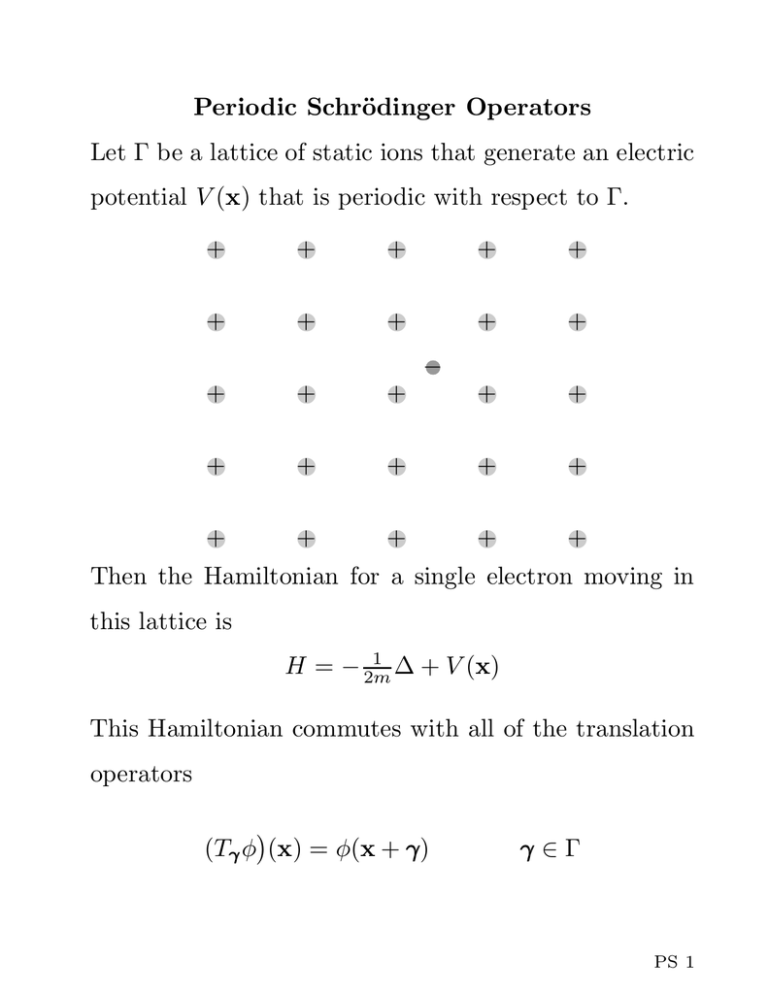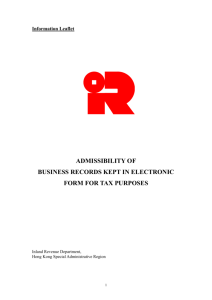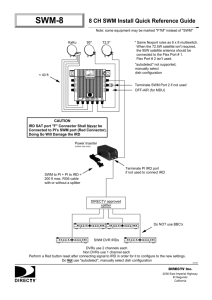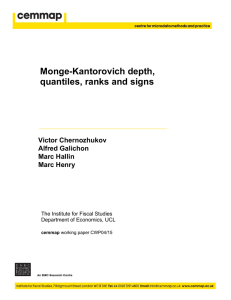Periodic Schr¨ odinger Operators
advertisement

Periodic Schrödinger Operators Let Γ be a lattice of static ions that generate an electric potential V (x) that is periodic with respect to Γ. + + + + + + + + + + − + + + + + + + + + + + + + + + Then the Hamiltonian for a single electron moving in this lattice is 1 ∆ + V (x) H = − 2m This Hamiltonian commutes with all of the translation operators (Tγ φ (x) = φ(x + γ ) γ∈Γ PS 1 Simultaneous eigenfunctions for these operators obey Hφα = eα φα Tγ φα = λα,γγ φα ∀γγ ∈ Γ Tγ is unitary ⇒ λα,γγ = 1 ⇒ λα,γγ = eiβα,γγ Tγ Tγ 0 φα = Tγ +γγ 0 φα ⇒ ⇒ λα,γγ λα,γγ 0 φα = λα,γγ +γγ 0 φα ⇒ βα,γγ + βα,γγ 0 = βα,γγ +γγ 0 mod 2π ∀γγ , γ 0 ∈ Γ Write Γ= n1γ 1 + · · · ndγ d n1 , · · · , nd ∈ ZZ For each α, all βα,γγ , γ ∈ Γ are determined, mod 2π, by βα,γγ i , 1 ≤ i ≤ d. Given any d numbers β1 , · · · , βd the system of linear equations (with unknowns k1 , · · · , kd ) that is d P γ i · k = βi 1≤i≤d γi,j kj = βi 1≤i≤d j=1 PS 2 (where γi,j is the j th component of γ i ) has a unique solution. So, for each α, there exists a kα ∈ IRd such that kα · γ i = βα,γγ i for all 1 ≤ i ≤ d and hence βα,γγ = kα · γ mod 2π ∀γγ ∈ Γ Notice that, for each α, kα is not uniquely determined. Indeed βα,γγ = kα · γ mod 2π, βα,γγ = k0α · γ mod 2π ∀γγ ∈ Γ ⇐⇒ (kα − k0α ) · γ ∈ 2πZZ ∀γγ ∈ Γ ⇐⇒ kα − k0α ∈ Γ# where the dual lattice, Γ# , of Γ is d # Γ = b ∈ IR b · γ ∈ 2πZZ for all γ ∈ Γ Relabel, replacing the index α by the corresponding value of k ∈ IRd /Γ# and another index n. Under the new labeling the eigenvalue/eigenvector equations are Hφn,k = en (k, V )φn,k Tγ φn,k = eik·γγ φn,k i.e. φn,k (x + γ ) = eik·γγ φn,k (x) ∀γγ ∈ Γ ∀γγ ∈ Γ PS 3 or equivalently, with φn,k (x) = eik·x ψn,k (x), 2 1 2m i∇ ∇ − k ψn,k + V ψn,k = en (k, V )ψn,k ψn,k (x + γ ) = ψn,k (x) Denote by INk the set of values of n that appear in pairs α = (k, n) and define Hk = span H̃k = span φn,k ψn,k n ∈ INk n ∈ INk Then, formally, and in particular ignoring that k runs over an uncountable set, 2 d L (IR ) = span φn,k k ∈ IRd /Γ# , n ∈ INk = ⊕k∈IRd /Γ# Hk unitary ∼ = ⊕k∈IRd /Γ# H̃k The restriction of the Schrödinger operator H to H̃k is 2 1 ∇ − k + V applied to functions that are periodic 2m i∇ with respect to Γ. PS 4 So what have we gained? At least formally, we now know that to find the spectrum of H= 2 d 1 2m 2 i∇ ∇ + V (x) acting on L IR , it suffices to find, for each k ∈ IRd /Γ# , the spectrum of Hk = 2 d 1 2m i∇ ∇−k 2 + V (x) acting on L IR /Γ . Unlike H, Hk has compact resolvent. So, the spectrum of Hk necessarily consists of a sequence of eigenvalues en (k) converging to ∞. The functions en (k) are continuous in k and periodic with respect to Γ# and the spectrum of H is precisely d # en (k) n ∈ IN, k ∈ IR /Γ PS 5 Rigorousification ⊕k∈IRd /Γ# H̃k = ⊕k∈IRd /Γ# span is implemented using d d # S IR /Γ × IR /Γ n d d ∞ = ψ ∈ C IR × IR ψn,k n ∈ INk ψ(k, x + γ ) = ψ(k, x) ∀γγ ∈ Γ e ib·x ψ(k + b, x) = ψ(k, x) ∀b ∈ Γ # with inner product hψ, φiΓ = Z 1 |Γ# | dk IRd /Γ# Z o dx ψ(k, x) φ(k, x) IRd /Γ and completion 2 d # d L IR /Γ × IR /Γ Also definen S IRd = f ∈C ∞ IRd Q d 2n sup (1 + x ) x Its completion is L2 (IRd ). f (x) <∞ ij ij ∂ j=1 ∂xj ∀n, i1 , · · · id ∈ IN o PS 6 Set (uψ)(x) = (ũf )(k, x) = 1 |Γ# | X Z dd k eik·x ψ(k, x) IRd /Γ# e−ik·(x+γγ ) f (x + γ ) γ ∈Γ ∞ (IRd /Γ) and set Let V ∈ CIR 2 d Dh = S IR h = i∇ ∇ + V (x) 2 d d # κ = i∇ ∇x − k + V (x) Dκ = S IR /Γ × IR /Γ Proposition S.3, S.5 There is a unitary map U such that U extends u, U ∗ = U −1 extends ũ and d # d S IR /Γ × IR /Γ dense 2 d # d L IR /Γ × IR /Γ u ũ U U∗ S IR d dense d 2 L IR Furthermore, h and κ have unique self–adjoint extensions, H and K, and ũhu = κ U ∗ HU = K PS 7 ∞ Now fix any k ∈ IRd and V ∈ CIR (IRd /Γ) and set 2 d ∞ hk = i∇ ∇x − k + V (x) Dhk = C IR /Γ Lemma S.7,S.8 a) The operator hk has a unique self–adjoint extension, d 2 Hk , in L IR /Γ . b) If =λ 6= 0 or λ < − supx |V (x)|, then λ is not in the spectrum of Hk . If λ is not in the spectrum of Hk , the −1 resolvent Hk − λ1l is compact. c) Let R > 0 and λ < − supx |V (x)|. There is a constant C 0 such that −1 −1 − Hk0 − λ1l ≤ C 0 |k − k0 | Hk − λ1l for all k, k0 ∈ IRd with |k|, |k0 | ≤ R. d) Let c ∈ Γ# and define Uc to be the multiplication operator eic·x on L2 (IRd /Γ). Then Ub is unitary and U∗c Hk Uc = Hk+c PS 8 Idea of Proof: Hk is a bounded perturbation of 2 d 2 i∇ ∇x − k , acting on L IR /Γ . The latter is diago- nalized by the Fourier transform. It’s spectrum is 2 # (b − k) b ∈ Γ Proposition S.9 The spectrum of Hk consists of a sequence of eigenvalues e1 (k) ≤ e2 (k) ≤ e3 (k) ≤ · · · with, for each n, en (k) continuous in k and periodic with respect to Γ# and limn→∞ en (k) = ∞. The limit is uniform in k. Theorem S.10 The spectrum of H is d # en (k) k ∈ IR /Γ , n ∈ IN PS 9









